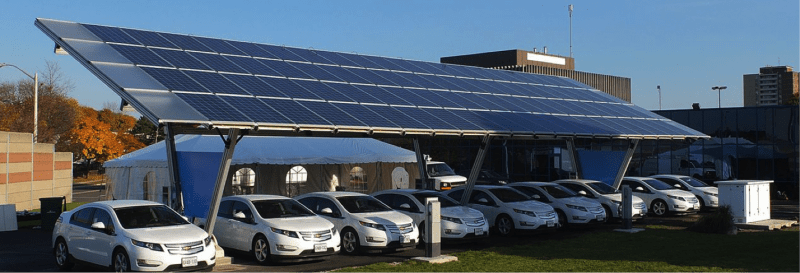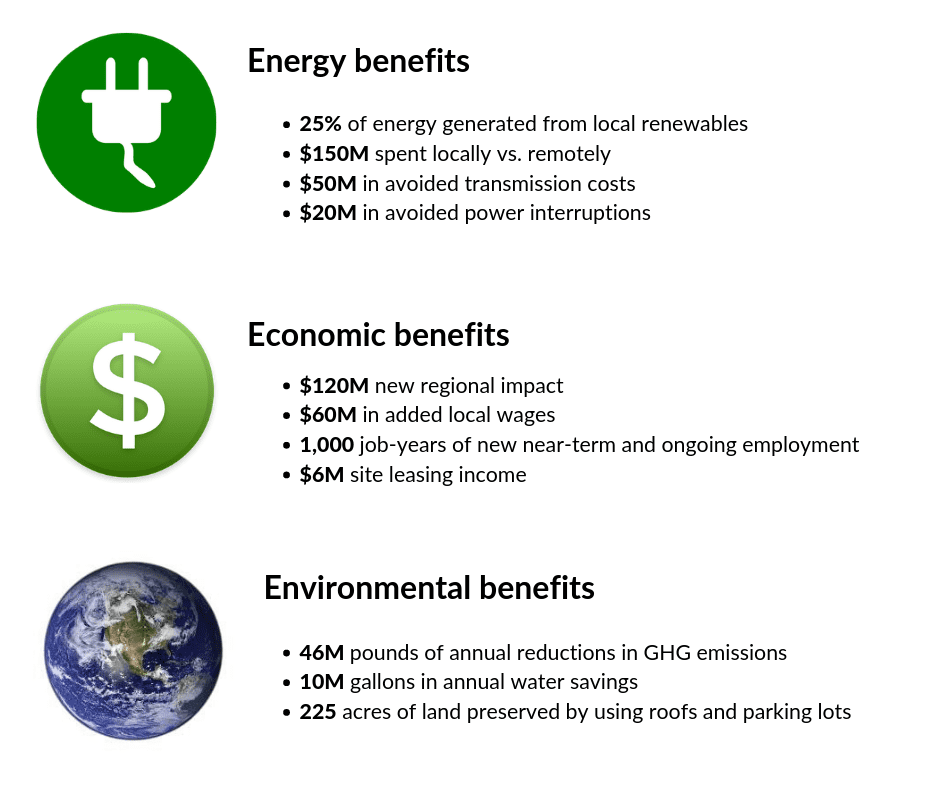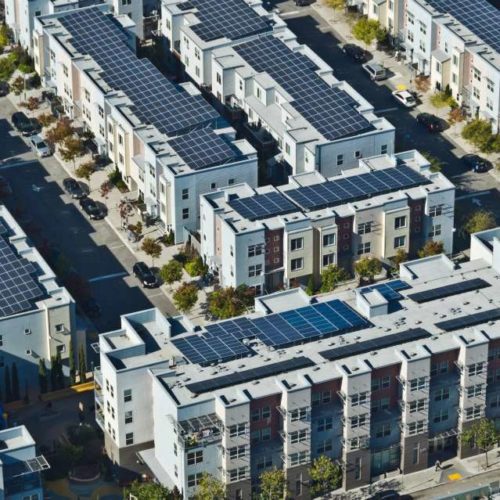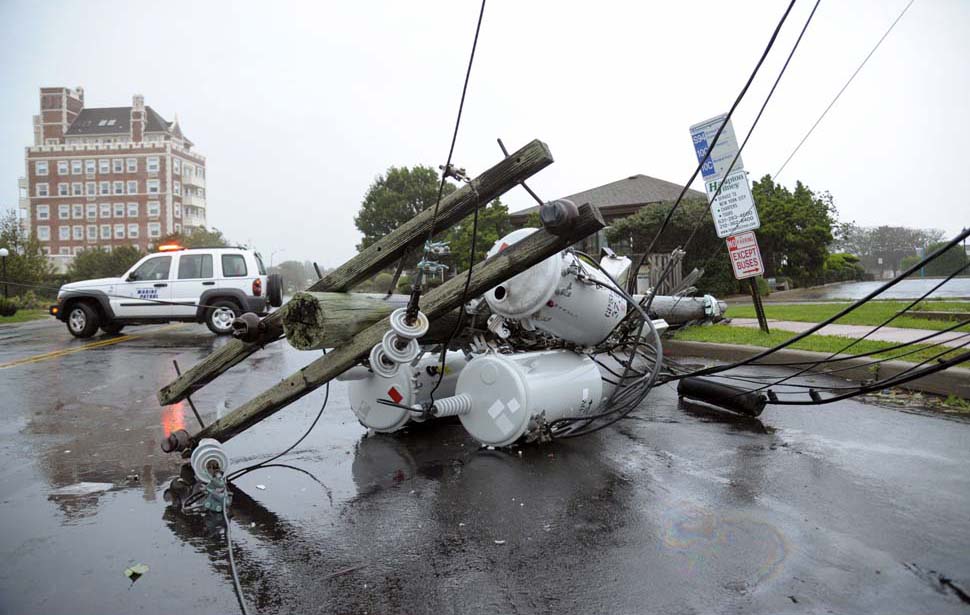Vote No on AB 942: Defend Rooftop Solar Affordability
Redwood Energy reports on Clean Coalition’s expert commentary, warning that AB 942 threatens rooftop solar affordability and undermines the clean‑energy transition
Read article
Examples of clean local energy's economic, environmental, and resilience benefits
What are the benefits of locally produced energy in terms of jobs, resource use, and local economic activity? We know that distributed energy generation can offset the cost of new remote generation and expensive transmission system investment — but how do we quantify that value?
Just like locally grown food, locally produced energy provides significant economic and environmental benefits to a community. Every electron produced on a rooftop and used by the surrounding neighborhood is one less electron that has to be produced by a large, distant power plant, then transported hundreds of miles across massive, expensive power lines. And every dollar spent locally on energy goes to create local jobs and investment.
A Clean Coalition analysis found that installing 30 MW of local solar PV on built environments in urban and suburban communities will produce these benefits over 20 years:

We can learn more by looking at the benefits of several Clean Coalition Community Microgrid projects.
A Community Microgrid is a locally based energy system — a small electric grid with its own electrical generation sources. It combines solar panels and other locally available renewable resources with advanced inverters, energy storage, and software-based control systems.
A Community Microgrid is linked to the main electric grid, but during a power outage it can isolate itself and keep running, providing power to critical facilities and other prioritized loads.

Renewables-driven resilience
The Goleta Load Pocket Community Microgrid (GLPCM) will showcase the power system of the future. The Goleta Load Pocket, a disaster-prone, transmission-vulnerable 70-mile stretch of Southern California coastline, provides the perfect opportunity for a comprehensive Community Microgrid that will bring the area an unparalleled trifecta of economic, environmental, and resilience benefits.
To achieve indefinite renewables-driven backup power that provides 100% protection to the GLP against a complete transmission outage, 200 megawatts (MW) of solar and 400 megawatt-hours (MWh) of energy storage needs to be sited within the GLP. This is highly achievable.

Energy storage and microgrids
The Valencia Gardens Energy Storage (VGES) project will add 1,096 kilowatt-hours (kWh) of electric energy storage to the existing 800 kW of rooftop solar at the Valencia Gardens public housing complex in San Francisco’s Mission District. The VGES project will provide these benefits per 1 MW of added solar over 20 years:
Economic/energy benefits:
Regional environmental benefits:

Redevelopment and local jobs
The Hunters Point Community Microgrid Project (HPCMP) is a deep-dive collaboration with Pacific Gas & Electric (PG&E) into the potential for producing and using local solar energy in the San Francisco Hunters Point district.
Using the Clean Coalition’s Solar Siting Survey and powerflow analysis tools, we identified over 50 MW of rooftop solar capacity in the area — and demonstrated that this robust buildout of solar can provide significant benefit to PG&E’s energy system while bringing many millions of dollars in economic benefits to this disadvantaged community.

Keeping the lights on
Located in the grid-constrained East End of Long Island and covering thousands of utility customers, the Long Island Community Microgrid Project (LICMP) is designed to provide 45% of the area’s energy needs from local solar generation using 15 MW (DC) of solar PV generation. With 25 megawatt-hours of energy storage, the project would eliminate the need for diesel generators that are currently used during the peak summer months and defer major transmission upgrade costs.
Like the Hunters Point Community Microgrid Project, the LICMP will provide significant economic benefits to the local community. A benefit/cost analysis was performed by an independent evaluator as part of this project proposal.
The examples above show the economic and environmental value of local renewables. But there’s one area that has yet to be quantified: energy resilience. The Clean Coalition defines resilience as the ability to keep critical loads online indefinitely in the face of extreme or damaging conditions.
It’s clear that there’s significant value to the resilience provided by indefinite renewables-driven backup power for critical loads. However, there is not yet an agreed-upon Value of Resilience (VOR). A VOR standard is sorely needed, and its absence represents a significant gap in the market for Community Microgrids.
At the Clean Coalition, we’re developing a standardized VOR metric to unleash this key market. Our goal is to make it simple to quantify VOR, starting with our VOR123 methodology, which standardizes VOR for Tier 1, 2, and 3 loads across all facility types.
We can define critical loads in terms of typical percentages of total electric load:
Establishing a methodology based on these load tiers ensures that the methodology can be easily applied to any type of facility. Each facility can determine how it wants to stratify between Tier 1, 2, and 3 loads.
What’s the value of electricity? On a temperate afternoon, a short power outage may have little impact on your day. But inside an elder-care facility in the middle of a winter storm, access to electricity literally becomes a matter of life and death.
Serving a vulnerable area hard-hit by Hurricanes Irene and Sandy, the Long Island Community Microgrid Project (LICMP) is designed with energy resilience at its core. Developed in partnership with the Long Island electricity transmission operator and the local municipal utility, as well as the county water authority and fire district, the LICMP will greatly enhance resilience by providing indefinite renewables-driven backup power for critical community facilities. The project will serve 3,200 utility customers, 21,000 water customers, and up to 20,000 residents covered by the fire district.

Critical loads in the LICMP area include two water pumping facilities and a local fire station. Right now, backup power is provided to these facilities using dirty diesel-fired generators, which must be cycled regularly for maintenance and are vulnerable to fuel supply interruptions in times of disaster. In the event of a regional or local power outage, instead of diesel, the microgrid would maintain service to these critical facilities. Surplus energy from the microgrid would also be provided to other prioritized customers, as resources allow.
The value of this robust resilience will amount to $334,000 per day in avoided losses for the community during regional energy disruptions. Beyond the LICMP, the Clean Coalition is working to develop a standardized Value of Resilience (VOR) that will enable municipalities, utilities, businesses, and others to effectively consider this value when analyzing Community Microgrid economics — resulting in more Community Microgrids being deployed.
In addition to the value of resilience and the local economic impacts, Community Microgrids can solve unique local energy challenges and can create significant system-wide cost savings. The LICMP will set the stage to avoid hundreds of millions of dollars in transmission investments that would otherwise be required to deliver power to the East End of Long Island.
Clean local energy has already been proven to offset transmission costs. In 2017 – 2018, the California Independent System Operator (CAISO) cancelled $2.6 billion worth of approved transmission projects because faster-than-expected deployment of clean local energy and energy efficiency eliminated the need for this expensive transmission.
Like many coastal towns, East Hampton, located on the southern shore of Long Island, sees its population swell during the summer. This seasonal increase pushes the electric grid to the max, as more air conditioners, laptops, and other devices demand power.
Depending on geography, regulation, and other circumstances, solving this kind of challenge with local energy generation can be far less expensive than adding centralized power plants and high-voltage transmission lines.
This is a critical concept: in what are known as “grid-constrained” communities, the existing electrical transmission system is incapable of easily being expanded to serve the changing needs of residents. In these scenarios, planners now have a choice: they can build additional expensive long-distance transmission lines — historically, the most common approach — or choose to build local energy systems, which are more cost-effective and much more robust during disasters.
The LICMP will potentially avoid a total of $38 million in new local transmission capacity spending, resulting in an immediate net cost benefit for all electric utility ratepayers.
The latest in clean local energy
Learn about our innovative projects and initiatives on our blog, and see what others are reporting about our important work.
Redwood Energy reports on Clean Coalition’s expert commentary, warning that AB 942 threatens rooftop solar affordability and undermines the clean‑energy transition
Read articleThis Clean Coalition hosted webinar took place on 27 June 2025 at 10:00 AM PST.
Read MoreThis blog post highlights the RGL Community Microgrid, which will provide clean energy and resilience to a disadvantaged community (DAC), utilize master metering, and serve as a critical model for future multi-unit housing (MUH) projects and master metering policies.
Read More